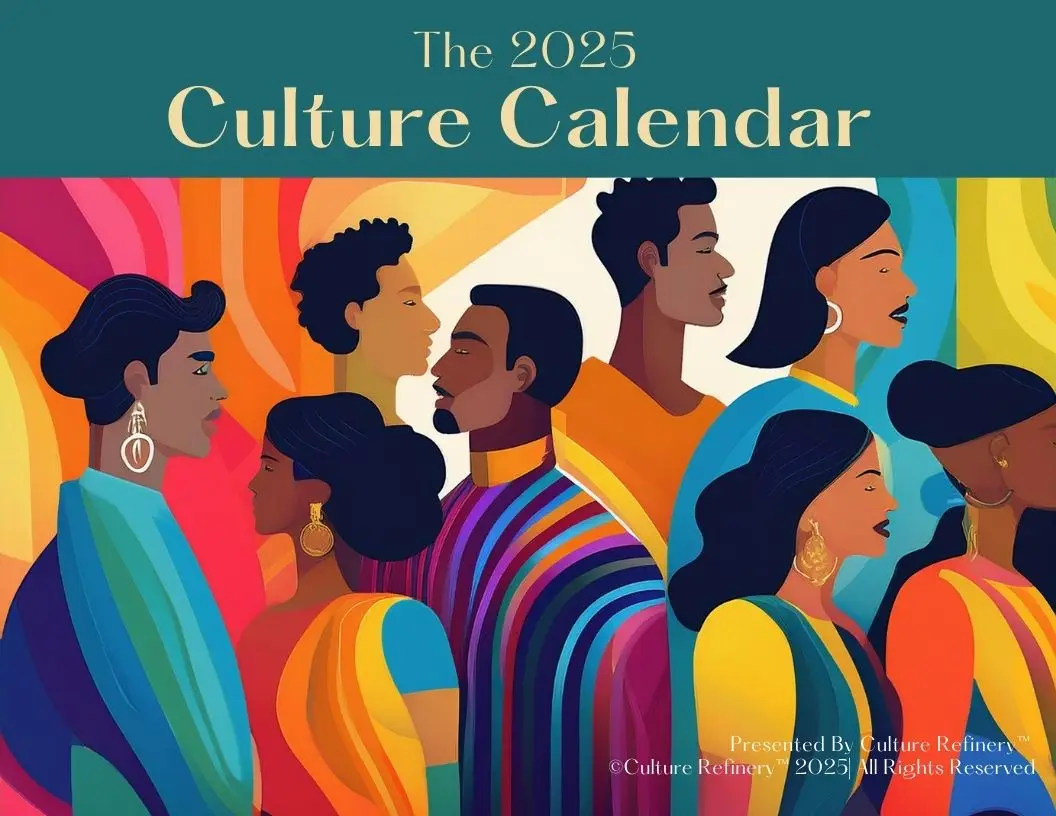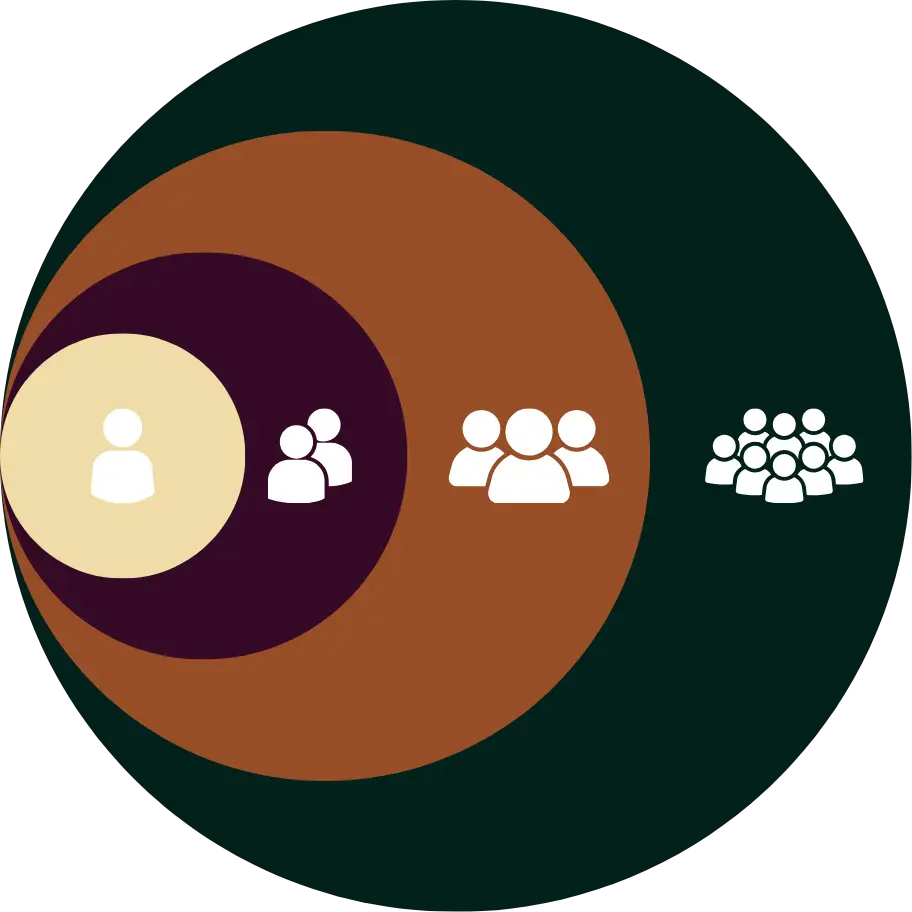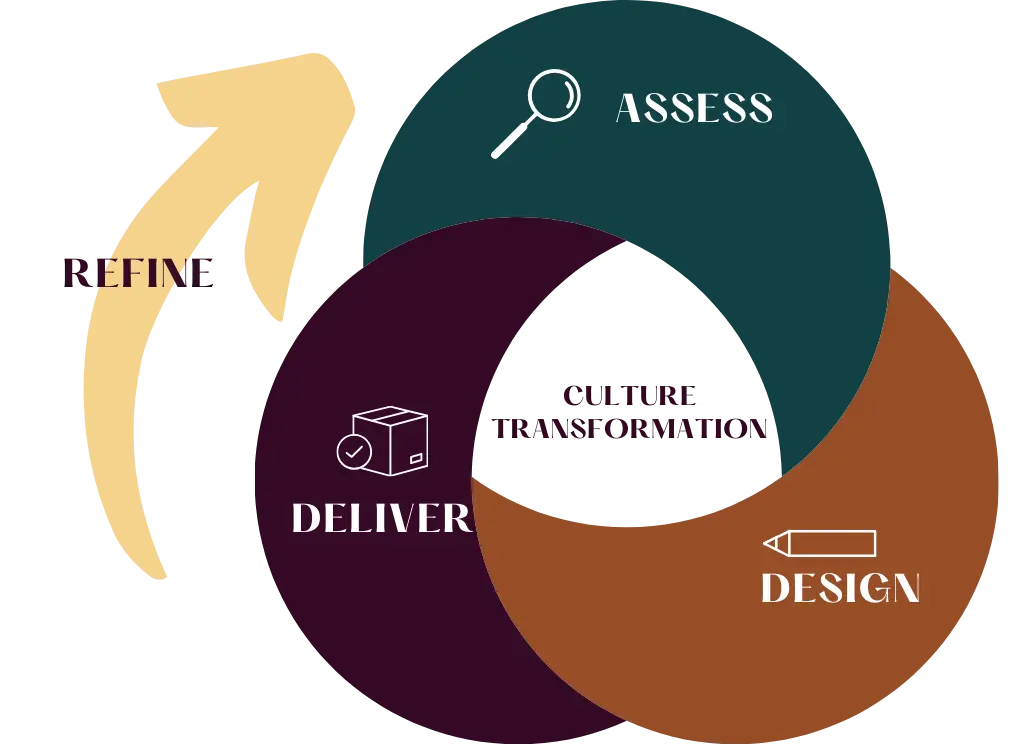Optimize the return on your organization’s most critical investment, your talent.
Top talent has choices. Your workplace culture is more than a buzzword, it’s your organization’s most powerful competitive advantage. Culture Refinery partners with companies to build leadership and cultivate environments where top talent thrives, innovation flourishes, and engagement soars.
At Culture Refinery, we understand that a thriving workplace culture requires effective leadership, talented team members, ongoing professional development, and a commitment to intentionally cultivating a supportive and psychologically safe work environment.
An environment where people naturally show up as their best selves and contribute their most genius ideas, fostering unparalleled employee retention, productivity, innovation, profitability, and impact.

That’s why we crafted our 2025 Culture Calendar, a comprehensive guide highlighting over 250 cultural dates, observances, and celebrations. This is more than just a calendar; it’s a testament to our commitment to fostering diversity, equity, inclusion, and belonging within organizations.

Leveraging our firsthand experience as organizational leaders, the Culture Refinery team collaborates with organizations, executives, managers, and teams committed to building effective and resilient organizations.
At the heart of our approach is the Culture Triangle Framework™, which focuses on the three essential components of a thriving workplace: Competence, Inclusion, and Alignment. These pillars ensure your organization fosters an environment where:
We are more than a consultancy; we are your strategic partner in driving employee engagement, manager effectiveness, team collaboration, and workplace productivity.
Our tailored solutions
We lead with our “inside out” approach to ensure that the development of your leaders and teams drives both internal and external impact. When you partner with Culture Refinery:
Together, we help you build a sustainable workplace culture that drives engagement, retention, and growth from within.

Our clients know that long-term success requires a dedicated partnership built on a shared vision of sustainable growth. Our solutions are adaptable and scalable, allowing us to support a wide range of clients, from global Fortune 100 companies to fast-growing startups, tailored to meet their unique goals and challenges.
We are honored to have partnered with values-aligned, people-focused organizations across various industries, including manufacturing, healthcare, financial services, technology, non-profit, and more.
Organizations we have partnered with








What sets us apart? A realistic and holistic approach to talent and leadership development. Our team brings extensive leadership experience from sectors like manufacturing, financial services, and technology, ensuring that our solutions are grounded in reality and tailored to your team’s unique needs.
Our Solutions Build
Are you ready to optimize the potential of your talent, elevate the impact of your managers, and drive sustained success in your organization?
At Culture Refinery, we create transformative learning programs that help to unleash the genius within your teams, fostering an environment where innovation, productivity, and engagement thrive.
If you’re ready to transform your workplace and achieve greater results, you’re in the right place.

Our proven Culture A.D.D. Framework™ is designed to address critical business challenges such as talent attrition, team dysfunction, employee disengagement, and leadership inefficacy. We start by meeting you where you are and guide you through a structured process to develop and implement leadership and talent development solutions that align with your strategic goals.
Our Process:
What This Looks Like
Are you ready to enhance your leadership capabilities, boost employee engagement, and drive sustainable growth?
Explore our suite of customizable talent and leadership development solutions.
At Culture Refinery, we champion the concept of a “Culture for Every One,” where visionary leadership meets effective team dynamics. Our motto, “Cultivate Culture | Unleash Genius,” embodies our commitment to empowering individuals to show up fully and authentically as their whole and best selves. We believe that when people bring their full potential to the table, the possibilities for innovation, growth, and success are endless.
We help bridge the gap between leadership vision and team execution, fostering lasting improvements in employee engagement, productivity, and customer satisfaction.
Explore how our consulting engagements, leadership development programs, team-building workshops, and coaching services can transform your organization and unlock the genius within your team.
Ready to create meaningful and lasting impact?

Join our mailing list get the latest in workplace culture and professional development directly to your inbox
The 5 key leadership shifts that separate overwhelmed managers from high-impact leaders.
Read this excerpt from Julie Kratz’s Forbes article The 2024 Outlook for DEI. What are some ways your organization can make diversity, equity, and inclusion work a row, not a column?
Encourage your leaders to read this report on Building Inclusive Teams, which offers five tactics for ensuring inclusivity at work. Poll the group: if they were to add a sixth recommendation, what might it be? Make a list of the tenets of inclusivity they find most important for your organization. Then, discuss how you might uphold these principles going forward.
Review page 21 of our Inclusion Starts with “I” Participant Guide, which offers strategies for rebuking subtle acts of exclusion as an Observer. Which of these tenets do you think your team might need the most support in consistently applying?
Take a look at the handout Responding to Acts of Exclusion with your team. Then, take all that we’ve shared and create your own process/framework to respond to subtle acts of exclusion. How will your leaders combat and disrupt exclusionary acts and model such behaviors for your team?
Intersectionality recognizes that various forms of oppression, such as racism, sexism, and ableism, don’t exist in silos: they overlap and create unique experiences for individuals who belong to multiple marginalized communities. A successful inclusive leadership strategy needs to consider how these systems of oppression interact and create amplified challenges for certain groups.
Read this HBR piece on An Intersectional Approach to Inclusion at Work. How can your organization move beyond sequential inclusion to consider the intersectionalities of employees, ensuring that no one is left behind? Reflect on current practices and identify areas for improvement.
Watch the ~2 minute video Kids Explain Intersectionality with your leaders. After watching, invite the team to develop their own definition of intersectionality and discuss how your organization can ensure that the voices of those who might face multiple barriers due to the intersections that make up their identities are heard and acted upon.
Revisit the Five Competencies of Inclusive Leaders, detailed on page 4 of our Inclusion Starts with “I” Participant Guide. How have you seen your team members display growth in each of these areas over the last several months? This is a great opportunity to “shout out” any colleagues that have demonstrated exceptional commitment during this journey!
As a group, take a look at the second page of the Inclusive Leadership Matrix, focused on Actions. Invite your leaders to evaluate which stage of the matrix they fall under for each competency. In what areas have they taken action over our time together? What are the areas they’re most excited to progress in next?
Visit The Micropedia, clicking on each volume on the right side of the screen to investigate microaggressions commonly experienced at various intersections of diversity. Were there any microaggressions depicted here that you did not expect? Are there any you have witnessed or experienced in your workplace?
Check out this Harvard Business Review article, Where Does DEI Go From Here? How can companies create a culture that encourages taking risks and learning from mistakes, especially for those in marginalized groups who may face harsher consequences for failure?
Take a look at this report on a recent University of Florida study on the impact of workplace bias on management. As you read, consider what ways microaggressions sparked by such biases might impact the daily work experiences of individuals from marginalized groups. What strategies can be implemented to mitigate these interactions?
Together, watch the first 3 minutes and 45 seconds of this video from the BBC. As a group, discuss: have you ever experienced or witnessed a microaggression at work? How did you react? What might you do differently in the future?
Read our latest blog post, The Neuroscience of Effective Feedback: Earning the Right to Make a Lasting Impact. The article discusses natural responses to feedback such as saving face, losing perspective, and projecting motives. What strategies have you found effective in helping team members keep perspective and not catastrophize when receiving feedback?
Review the four components of effective feedback above. Then, beginning at 0:26, watch this segment from The Way We Work as a group. After tuning in, invite your team to map out one of their upcoming feedback conversations using this outline.
Check out the article How to Help (Without Micromanaging), then consider the following questions.
Watch the first 1:45 of this excerpt from Masters of Scale with your team. Discuss your reactions as a group after tuning in. How might the 20% policy foster psychological safety? Is this something your organization would ever try? Why or why not?
Watch the end of this TED Talk on encouraging innovation from the head of Google’s Moonshot Factory X, Astro Teller, starting at the 13:40 mark. After watching, consider: what are some actionable ways you can make failure the path of least resistance in your organization?
Read the HBR article Four Steps to Building the Psychological Safety That High-Performing Teams Need. After reading, explore these four steps with your team by grabbing your sticky notes and drawing a large circle on a whiteboard (virtual version) and asking your team to add examples of practices for each step that represent psychologically safe or unsafe environments, with safe practices going in the circle and unsafe practices going outside.
For example: If the topic is step 3, “Ensure that all people feel ‘seen,’” a sticky note with “asking a colleague about their weekend plans” might go inside the circle, whereas a sticky note with “talking over each other” would go on the outside.
As your leaders add their thoughts, outline strategies for upholding these practices, and determine the frequency of reviews to ensure their ongoing effectiveness.
As your leaders consider the importance of psychological safety in high-stakes environments, reflect on your experiences navigating competing demands when crucial decisions must be made.
Compare the Challenger with the Columbia as a group. In both cases, the lack of psychological safety proved fatal: engineer Bob Ebeling (’86) rang alarm bells and was disregarded by the organization, and engineer Rodney Rocha (’03) was too intimidated to speak up, despite NASA supposedly renewing their commitment to safety in the wake of the first disaster. Together, investigate:
What are some practical steps organizations can take to foster an environment where dissent is encouraged and valued, and how can leaders ensure they are genuinely open to hearing and acting on these alternative perspectives?
Read The Four Stages of Psychological Safety. Which stage do you think is most challenging to achieve, and why?
To further this study with your leaders, we encourage you to watch Timothy Clark’s keynote presentation on the four stages of psychological safety from 3:16-5:55 together. Then, explore the following question: what strategies are you employing to design a sanctuary of inclusion and/or an incubator of innovation within the context of your role?
Read this excerpt from the article No Fail, No Fear about the way Viola Spolin, the Mother of Improv, approached generating psychological safety.
Share the article No Fail, No Fear with your leadership team, then discuss the following questions:
Read the Harvard Business Review article What Is Psychological Safety to guide your upcoming conversations on psychological safety with your team. What does a psychologically safe workplace look like to you?
Review existing organizational policies with an eye for bias. Do you spot any opportunities for increased cultural competency surrounding promotion structures, flexible work arrangements, recruiting, etc?
Present your findings to your executive team, discussing the key takeaways from your reflection above.
Write each of your team member’s names on a sticky note. Then, divide their names into three categories: ready for a promotion now, ready within 1 year, and ready within 2 years. Then, sort each band into subgroups based on race and gender.
Come together with your senior leadership team and discuss your findings. Did any trends emerge? Are there any over or under-represented populations being prioritized for promotion?
Explore the Bias and Basketball activity. What were your initial reactions when contemplating your All Star lineup? Did you notice any of your own biases peeking through?
Discuss with your team – as an organization, are we exhibiting any biases in our own communications or marketing? How might we reflect our commitment to greater inclusivity in the ways we communicate as a company?
Gather the data you have available regarding employee engagement and manager effectiveness for your organization and present it to senior leadership — but rather than focusing on the standard, analyze the outlier. (So, for example, if 89% of your employees are engaged, invite your senior leadership team to take a deep dive into the 11% that are disengaged.) What number of employees do these percentages represent? What trends in demographics do you notice? Allow this reevaluation of the data to guide a deeper discussion with your senior leadership team.
Explore the Smithsonian activity “Be the Detective.” After reviewing the images and the explanations behind each card, discuss the activity with your team. What are their key takeaways from the exercise?
Try the 2×10 exercise. Identify a team member you haven’t deeply connected with — this could be someone new, someone quiet, or someone who might be facing challenges on the line. Schedule brief, intentional interactions with this team member throughout the week. Aim for 2 minutes a day for 10 consecutive days. Ask about their hobbies, interests, or upcoming plans outside of work, or non-critical work-related questions about what they enjoy about their role. Pay attention to their responses and ask follow-up questions.
After ten days have elapsed, reflect on any initial assumptions you may have had about the employee. Did you learn anything new about their background? Did you find new areas of common ground? By taking these small steps, you can build stronger relationships with your team, leading to a more positive and productive work environment.
Read this report from Qualtrics on Building Inclusive Teams. This article offers five tactics for ensuring workplace inclusivity. If you were to add a sixth recommendation, what might it be?
Share the first 2:30 of Netflix’s Primer on Allyship with your team. Then, guide your team in the Workplace Bystander Intervention discussion and self-assessment.
Tune in to this 4-minute breakdown of Allyship. After you watch, consider the implications of staying silent in the face of workplace exclusion. What are some concrete actions you can take to support colleagues or team members who may be experiencing these exclusionary acts, even if speaking up feels uncomfortable?
Distribute the handout Intersections and I and give participants 3 minutes to identify the attributes that represent a part of their identity. Afterward, go around the room and ask participants to share a few that they selected with the group.
Then, ask participants: “What if I told you that you could only select one attribute from your sheet? How would that make you feel? Could you make that selection?”
Following the discussion, offer the definition of intersectionality, underscoring the importance of creating safe and supportive teams that allow us to show up as our full selves in the workplace.
Intersectionality refers to the overlapping or intersecting social identities that make up an individual. This concept acknowledges how various identities interweave and create unique experiences for each person. What we know from external research is that when we ask individuals to bury attributes of identity, it impacts their ability to perform, to connect, and their commitment to the organization. When we expend more energy working to obfuscate who we are than we do focusing on our jobs, productivity and innovation dramatically decrease.
Watch Kimberlé Crenshaw describe the origin of the term “intersectionality” in this TED Talk, from 4:55-10:05. After tuning in, consider:
Prior to your next meeting, invite your team members to explore The Micropedia, clicking on each volume on the right side of the screen to investigate microaggressions commonly experienced at various intersections of diversity. When your team comes together, discuss:
Assess your progress in developing the Five Competencies Inclusive Leaders using this questionnaire.
Review the definition of microaggressions as a group, then watch How Are Microagressions Like Mosquitos? Then, discuss with your team: From repellents to nets, there are readily available solutions to prevent mosquito bites. What are some strategies for preventing and responding to microaggressions? You may wish to share page 19 of your Participant Guide as a resource for your team following the discussion.
Review this infographic on the state of equity in the American workplace. Did any of the statistics surprise you? How have you noticed these trends play out in your career? What, if anything, can you do to help create more parity?
Review this infographic on the state of equity in the American workplace. Then, discuss: Did any of the statistics surprise you? How have you noticed these trends play out in your career? What, if anything, can you do to help create more parity?
Studies show companies with diverse and inclusive teams see a 20% increase in innovation and 25% higher profitability. The data also shows there’s plenty of work to do… but an inclusive workplace truly benefits everyone! Read our blog post on The State of Workplace Equity for more background data and statistics.
With your team, watch Melinda Briana Epler’s TED Talk, 3 Ways to Be a Better Ally in the Workplace. After watching, ask each team member to write down one specific action they plan to take to be a more effective ally on the job.
Microaggressions are subtle, sometimes unintentional, behaviors or comments that convey prejudiced attitudes towards individuals based on their membership in a marginalized group. From consistently mispronouncing someone’s name even after being corrected to making assumptions about a colleague’s interests based on stereotypes, what might seem like an innocuous quip to one person can quickly embed pernicious ideas into the fabric of your organization. As Harvard Business Review points out, “The more you increase your awareness of microaggressions, the more you will inevitably notice they are happening — and wonder how or if you should intercede.”
Read the full text of the HBR article Recognizing and Responding to Microaggressions at Work. Can you think of a time when you’ve encountered a gap between intent and impact
Practice makes perfect! In the coming days, aim to give each of your team members at least one piece of valuable feedback, leveraging the Before the Candor preparation framework prior to each discussion. (Remember, this process can be utilized for both constructive and positive feedback — a pat on the back for your strongest performers can be nice, but consistently fostering actionable conversations focused on cultivating growth can take the team’s innovation potential to the next level!)
Former Deere CEO Bob Lane once shared a powerful statement that continues to resonate nearly two decades later: “A company has to earn the right to grow.” Similarly, when it comes to feedback, we must earn the right to give it. Simply holding a position of authority doesn’t automatically grant us permission to provide feedback—or at least, not feedback that’s received and leveraged effectively. That’s why developing a psychologically safe environment is crucial.
Review our guide to preparing to deliver feedback, Before the Candor. After reading, consider: how do the principles of psychological safety that we’ve focused on over the last month help you earn the right to give feedback? How might a psychologically safe workplace influence how feedback is received and implemented?
Sometimes, the best way to learn what your people need is to simply ask them! Have your team members write down the qualities of their favorite and least favorite past managers. After they’ve had a few minutes to compile their lists, share and discuss.
General George S. Patton famously said, “Never tell people how to do things. Tell them what to do, and they will surprise you with their ingenuity.” A key component of psychological safety is the freedom to explore, create, and innovate. But as a leader, it can be immensely challenging to take the proverbial training wheels off for your teammates and watch them wobble as they find their way.
So what steps can you take to maintain psychological safety to create more space for innovation? Start by taking this quick quiz to learn more about your management style.
Share this 3-minute mini-documentary on Purpose in the Workplace with your team. After you watch, offer your reflections on why your work matters to you to the group. Then, encourage each team member to identify and share one of their personal core values that often shows up in their work.
Watch Amy Edmonson’s interview on HBR’s The New World of Work from 28:25-31:15. In this clip, Edmonson recommends that to re-energize your team in the wake of failure, it’s imperative to reconnect with your own sense of purpose and share what you discover. Take a few moments to consider why your work matters to you.
Watch this bite-sized case study (Transcript) of another infamous NASA explosion with your team. Then, engage your team in the following conversation around psychological safety: Rodney Rocha had a tentative concern that he hesitated to voice. What strategies can our team implement to ensure that all concerns, even those that are uncertain or incomplete, are welcomed and seriously considered during discussions? How might this change the outcome in high-stakes situations?
Read the article 3 Leadership Lessons from the Challenger Disaster. After reading, consider — what are some effective strategies that leaders can use to maintain their stance when core values are challenged by pressures such as tight schedules or external expectations?
Watch Timothy R. Clark’s presentation on Building Psychological Safety at Work from 11:07-15:37 with your team. Afterwards, divide into four groups for a deeper exploration of the four stages of psychological safety, assigning each group a different stage. Have the groups develop their own definition and example of their stage, using an excerpt from Clark’s article for support. When everyone reconvenes after ~5 minutes, ask each group to divulge what they devised. Then, discuss:
How might your team better encourage and protect these behaviors in your workplace?
Psychological safety refers to an environment where team members feel confident to take risks, voice their opinions, and express their ideas without fear of punishment or ridicule. In such a culture, mistakes are viewed as learning opportunities, fostering a growth mindset among employees.
Watch Timothy R. Clark’s presentation on Building Psychological Safety at Work from 6:22-10:23. After watching, consider: what are some ways that acts of vulnerability are rewarded on your team? Are there opportunities to celebrate vulnerability that you might not be leveraging to the fullest extent?
Play the games “Shared Memory” and “Let’s Plan a Party” with your team, making sure to take the time to debrief after each experience.
Google’s Project Aristotle, a research initiative aimed at understanding the dynamics that create the most effective teams, challenged traditional notions of team building by focusing less on assembling a team with the right mix of professional skills and more on creating the right environment for teamwork to flourish.
Read What Google Learned From Its Quest to Build the Perfect Team. A critical finding of Google’s analysis was that teams perform best when members feel safe to take risks and be vulnerable in front of each other.
After reading, consider – how can leaders encourage failure to feel like a stepping stone rather than a setback?
As you explore psychological safety further, we would encourage you to read the Harvard Business Review article What Is Psychological Safety to guide your upcoming conversations with your team.
To accompany this reading, we would suggest the following exercise.
Watch Amy Edmondson’s TED Talk, Building a Psychologically Safe Workplace. Professor Edmonson suggests that it’s possible to demand high standards and hold people accountable while also ensuring psychological safety, thereby creating a “learning zone” where people are not afraid to admit mistakes, ask questions, or offer ideas. After watching, reflect on how this balance (or lack thereof) has been managed in your experiences.
Invite your team to complete The Top 5 People You Trust exercise that we did together. Check across demographics, and scratch off names with 3+ areas of similarity. After discussing your group’s findings:
We approach every interaction we have with our own unconscious cultural framework — also known as bias. Developing cultural competence helps us understand, communicate with, and effectively interact with people across cultures. It makes us more compassionate, thoughtful and effective in our work. Cultural competency is not a skill that you master and check off of a list — instead, it is a practice that you sustain over time through continuous action.
While you are building your cultural competency, we encourage a four step approach:
Identify your own biases and demonstrate genuine interest in better understanding the culture of others.
Translate that curiosity into action by researching and expanding your vision. This requires you to do your own work and to actively listen to understand, not to respond.
Notice we say relationship and not relationships because we want to encourage everyone to cultivate relationship at the individual level. No subgroup of people are monolithic, and to truly demonstrate cultural fluency, we must connect with people as individuals first. Be mindful that one size does not fit all.
No one walks a perfect path. Plan for mistakes. Extend yourself and others grace, and leverage those mishaps to inform and improve your practice.
Revisit page 13 of your Participant Guide to flesh out your plan for building cultural competency. What specific strategies will you employ to deepen your practice across each of these steps?
With your team, view the first 5 minutes and 10 seconds of Nudge Behavior for a More Inclusive World. Be sure to pause during the warmth/competence ranking activity (from 1:00-1:15) to allow your team to raise their hands. Afterwards, ask your team:
Watch the the TEDX Talk Nudge Behavior for a More Inclusive World by anthropologist Tinna Nielsen. After tuning in, reflect on the speaker’s call for individuals to contribute to making the world more inclusive.
Nielsen suggests three ways to move the unconscious mind for inclusiveness: eye-opening experiences, designing processes, and framing perceptions.Can you think of examples in your professional life where these strategies could be applied to create a more inclusive environment?
Share the following handout, Bias and Basketball, with your team at your next staff meeting. After they have selected their starting lineup, discuss:
Take a few minutes to read Your Brain and Bias from the NeuroLeadership Institute and Greater Good Magazine’s How to Work With the Bias in Your Brain. After reading, reflect.
Compare the approaches suggested by NLI with Eberhardt’s recommendations. How do these approaches complement each other in addressing bias at individual and institutional levels?
During your next staff meeting, pose the riddle from the exercise Who’s the Surgeon? to your team members. After your team has weighed in, share page two of the exercise reveal the answer, and discuss your reactions. Additionally or alternatively, share the Brain Facts video above and facilitate a discussion on the reflection question, leveraging your own reflection as a springboard for the conversation.
Most of us have heard references that the brain is like a computer, receiving and processing information, deciding what to do with the information, and then taking (or in some cases avoiding) action. Sometimes that whole process is conscious and intentional, but often we don’t even realize it’s happening. From the time that we were born until we were about 7 years old, our subconscious brain formed the foundation of our preset beliefs and perceptions based on the people around us, the music we listened to, the TV shows and movies we watched, etc. As we go through life, the things we experience and learn physically change the makeup of our brains in the form of mental maps. No two brains are the same, because no two people have the same exact life experiences in the same exact sequence to inform the brain and those mental maps (not even identical twins). As a result, you and I can see and hear the exact same thing, and perceive it completely differently.
Review this Who’s the Surgeon exercise and watch this ~1-minute video on How Experience Shapes Your Brain from BrainFacts.org. Jot down your thoughts and key takeaways.
Share the Smithsonian Bias Online Exhibit and select one section or activity to explore together and discuss.
Anchor Your Learning: Explore the Smithsonian Bias Online Exhibit. This interactive resource is full of informative and engaging content to help deepen your understanding and awareness of the biases that live inside of us all. Review the exhibit and make note of ways bias shows up in the products we are marketed every day.
Before you download the full version of the 2024 Culture Calendar, use the buttons below to add the date to you iCal or Google Calendar.
Skip adding the Culture Calendar to your iCal or Google Calendar and download your calendar here.